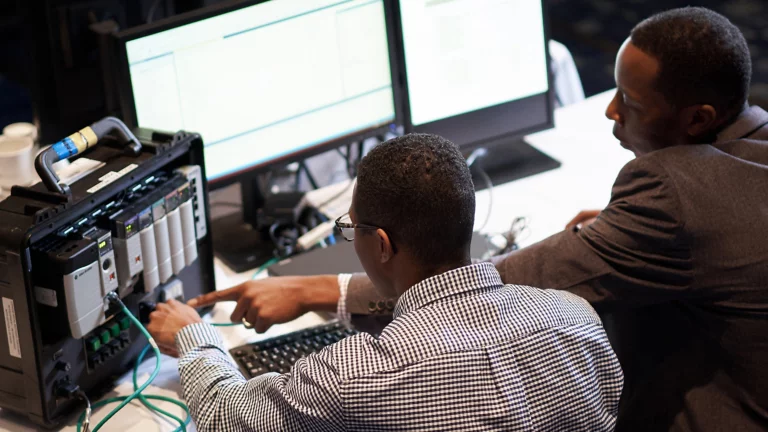
What is a PLC and How Does it Control a Process?
An introduction to PLCs including what a PLC is, what components make up a PLC, and how a PLC controls an automated process
Get new content delivered to your inbox every month.
No spam, unsubscribe anytime.
In this post, I’m going to explain:
Let’s get started by talking about what a PLC is.
A PLC, or Programmable Logic Controller, is a specialized industrial computer that is designed to control automated equipment and processes.
If you’re new to the world of industrial automation, you might wonder why we need PLCs. Why can’t a regular computer be used to control an automated process?
There are three core reasons why PLCs are used in industrial automation:
First, PLCs are easy to integrate with other devices. A PLC can communicate with hundreds or even thousands of different types of sensors and actuators. Often, connecting a device is as simple as wiring it directly to the PLC.
Second, PLCs are incredibly durable. PLCs use a special operating system that doesn’t require updates or patches. That operating system runs on solid-state components, so there are no moving parts to wear out. Those solid-state components are protected by a ruggedized housing that can survive in dirty and dusty environments. All of these features combined mean that PLCs can run for 10, 15, or even 20 years without stopping. You simply can’t get that kind of performance from traditional computers, which need regular updating and patching and are often obsolete in less than 5 years.
Finally, PLCs are simple to program and troubleshoot. As we will see later on in this video, PLCs are programmed using high-level, visual programming languages that are easy for technicians, electrical engineers, and process engineers to understand. This is really important for manufacturing environments because the people who operate and maintain automated equipment aren’t software engineers - they are electricians, technicians, and operators.
Now that we know why PLCs are used in industrial automation, let’s look at the architecture of a typical PLC.

PLCs come in many different shapes and sizes, but they are all made up of the same components.
.png)
The processor is the heart of the PLC and is responsible for executing the project that is downloaded to the PLC. The processor contains an interface that lets a programmer download a project to the PLC, non-volatile memory that stores the project, and a CPU that executes the project.
.png)
Input and output modules, also known as I/O modules, let the PLC interact with the physical world.
Input modules take electrical signals from input devices like push buttons and sensors and turn them into digital signals that the processor can understand.
Output modules take digital signals from the processor and turn them into electrical signals that actuate devices like lights and motors to control a process.
.png)
Communication modules let a PLC communicate with other devices on industrial networks like EtherNet/IP and PROFINET.
.png)
Finally, a power supply provides power to all of the components in the PLC.
.png)
In this example, each component is a physical module with its own housing. These modules are installed in a chassis to build a PLC system.
This is what is known as a modular PLC system and is the form factor used for large, powerful PLCs. A modular PLC system can be customized to meet a project’s needs. They are also easy to maintain since individual modules can be replaced without affecting the rest of the system.
.png)
Other PLCs have all of their components integrated into a single housing. This is called a compact PLC and is often used to control smaller processes.
Now that we know what components make up a PLC, let’s see how a PLC actually controls a process.
A PLC controls a process by monitoring inputs, executing its program, and controlling outputs.
These steps are executed in an infinite loop. Each iteration of the loop is called a scan or a cycle.
.png)
Let’s look at a simple example of a PLC controlling a conveyor.
In this example, the conveyor is started by an operator pressing the start button, and the conveyor continues to run until the sensor at the end of the conveyor is triggered.

At the start of every scan, the PLC checks the status of the inputs. In this case, the PLC is monitoring the input for the Start button and the sensor.
.png)
The PLC then executes its program. Simple programs like this one are generally written in the Ladder Diagram programming language. This is a high-level, visual programming language that resembles electrical schematics.
.png)
After executing the program, the PLC turns its outputs on or off to control the process.
.png)
Now you understand what a PLC is, what components make up a PLC, and how a PLC controls a process.
In my next video, I’ll introduce you to the Ladder Diagram programming language and explain how it is used to write PLC logic.
If you want to be notified when that video comes out, use the link below to sign up for my email list.